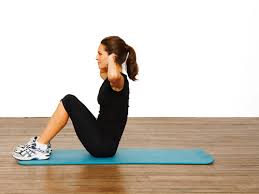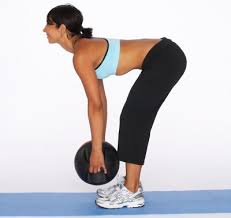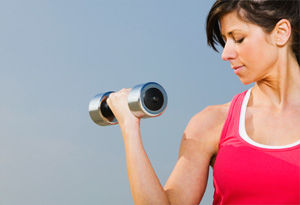Hi guys, we are back! We hope that you have learnt something from our previous post. For now, we will move on to the second part of getting six packs!
Building muscles
1)  Do crunches. Lie on the floor (with or without a mat) with your arms in front of your chest or with your hands lightly touching your temples (never behind your head). Bend your knees. Raise your shoulders (upper torso) towards your knees, using strictly your abdominal muscles. It is very important to not lift your entire back off the floor, as this can cause back strain, and the extended movement does not help you develop six pack abs any faster. The most important part of the crunch is the initial flexing of your abs as you lift your shoulders off the floor. As soon as you begin lifting off the floor exhale through your mouth, ending with a gasp once your shoulders are off the floor. Then pause for a second once you are at the top of the crunch and exhale the last bit of air from your diaphragm while flexing your abs. Now lower back down slowly and controlled while inhaling through your nose, just until your shoulder blades touch the ground. Do not let your head touch the ground.
Do crunches. Lie on the floor (with or without a mat) with your arms in front of your chest or with your hands lightly touching your temples (never behind your head). Bend your knees. Raise your shoulders (upper torso) towards your knees, using strictly your abdominal muscles. It is very important to not lift your entire back off the floor, as this can cause back strain, and the extended movement does not help you develop six pack abs any faster. The most important part of the crunch is the initial flexing of your abs as you lift your shoulders off the floor. As soon as you begin lifting off the floor exhale through your mouth, ending with a gasp once your shoulders are off the floor. Then pause for a second once you are at the top of the crunch and exhale the last bit of air from your diaphragm while flexing your abs. Now lower back down slowly and controlled while inhaling through your nose, just until your shoulder blades touch the ground. Do not let your head touch the ground.
2)

Do sit ups. Lie on the floor, feet on the floor, knees up and hands crossed on your chest. Have someone hold your feet down, or wedge them underneath something heavy. Sit all the way up, lifting your lower back off the floor along with your shoulder blades. Keep your back straight (no hunching). Lower yourself down. Repeat. Once this becomes relatively easy for you (i.e. you can do a quite a bit with ease) start adding more challenges. Find an incline bench. Do weighted sit ups. Hold a weight on your chest while you do these. As these become easier, hold heavier and heavier weights.
3)

Train your entire core. To build really great abs it's important to first understand what abs do. Their full name is 'rectus abdominis'. The 'rectus' bit, is Latin for 'straight, proper, upright'. Contrary to popular opinion, the abs' primary job is not to curl you up into a ball, but they work together with the back muscles to maintain correct posture and stabilize the spine. These muscles are not just for show! So the best exercises for abs are ones that force your entire core to go into overdrive to support your spine. Some exercises that do this are squats and dead-lifts. These exercises will train your entire core to work together to do what it is designed to do. At the same time they will also train a lot of other muscles (e.g. glutes and quads).
4)

Do leg lifts. Lie on the floor, legs straight out, hands at your sides. Lift your legs straight up (not bending your knees at all) until they're at a 90 degree angle (or close). Lower your legs and repeat without letting your legs touch the floor. For more challenge there is equipment at most gyms that will allow you to raise yourself up using your arms as support and dangle your legs. If you're using this piece of equipment, you can make it easier by just raising your knees to your chest. It's more difficult to raise your legs to a horizontal position with your legs straight. This helps firm up the lower abdomen. If you're truly a monster, try doing leg lifts with a medicine ball hanging from your feet. Or, hang from a pull up bar and raise your legs in front of you all the way up to the bar.
5)

Do jackknife sit ups. Lie down flat on the floor. Place your hands on the ground to your sides for balance; you can pick them up as you get used to the movement. Simultaneously raise your knees and torso so that your knees and face meet on an imaginary line extending from your pelvis to the ceiling. You should be able to kiss your knees at the top of the motion. Your legs will naturally fold bringing your feet towards your hips, much like a jackknife. Lie back down (i.e. "spread out") and repeat. Place a weight between your feet when you think you can handle it.
6)

Do static holds. Put your body into the push-up position but with your elbows on the floor, and your whole body flat. This position is known as the static hold position, or the plank, and it trains your core (including your abs) to hold the body in place which is the real purpose of your abs. Hold this position for as long as possible. Beginners should be aiming to start off with at least 45 seconds, while seasoned ab workers are known to achieve over 5 minutes static holds. To perform the side static hold, roll onto one side of your body and lift into the same position as before, but this time only one arm will be on the ground with the other arm pointed straight up the air and your non weight bearing leg resting on your bottom leg. Once again, hold this for as long as possible.
7)

Train your oblique muscles. It's not as important to work on your oblique muscles at first, but eventually you'll want to start working these too. These are the muscles to either side of your stomach. There are multiple ways to do this and anything that includes twisting your torso against a resistance counts. There are twisting machines at gyms, you can twist while you do sit-ups, you can do side bends, you can twist side to side with a medicine ball in hand, etc. Be aware though, that many beginners tend to have weak oblique compared to their abs (it simply isn't used as much in daily life) so go easy on the sides at first.
- Do bicycle crunches. Lift your feet off the ground while doing the crunches by alternating each leg in the air. Bring your left knee up toward your right shoulder and then your right knee toward your left shoulder.
8)

Find new ways to crunch, bend and twist in your daily life. Some possibilities include:
- Use a stability ball.
Use a stability ball. Do your crunches on the ball to introduce instability to your workout, which will improve your balance too. There are also lots of core exercises that can be done with a stability ball. You can also use a small bubble used for physical therapy.
- Duck and twist during your daily routine. Reach with your left hand to things on your right and vice versa. If you feel like turning around to face something, see if you can do it with keeping your hips in place and twisting at the waist. (This is awkward when talking to other people, use only against inanimate objects.) While walking or standing, pretend that something is coming toward you and you have to duck to get out of the way. Do this as often as you are comfortable or at times when it won't look weird. You can bend forward from the hips or, if you're really into it, bend at the knees too and really "sink" out of the way.
- Add complex core-movements to your workout. That will boost your overall body constitution tremendously. For example, combine push-ups with rows. Go into a push-up position on two dumbbells. Now don't do a push-up, but instead start to row alternating dumbbells. See how much power you need only to hold balance? Combine exercises! Be creative. Tension is your friend.




